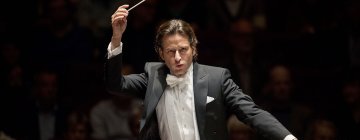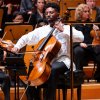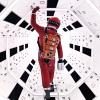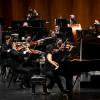
No longer in the wunderkind category but still young by conductor standards, 38-year-old Teddy Abrams returned to Walt Disney Concert Hall on Sunday afternoon, May 25, amid increased speculation about his future.
Abrams is rumored to be among the candidates to succeed Gustavo Dudamel as music director of the Los Angeles Philharmonic. He’s bright, energetic, versatile, a born communicator, and a risk-taking cross-genre programmer who has frequently conducted here. He seems happy as music director of the Louisville Orchestra, tending to the musical life of that city, but if an offer came from L.A., it would be difficult to pass up.
Over the weekend, Abrams set out to revive a theme he’s pursued in Phil previous appearances: exploring the universe at futuristic Disney Hall. A 2018 concert set found him leading Yuval Sharon’s cast-of-hundreds production of Andrew Norman’s A Trip to the Moon as a multimedia prelude to Gustav Holst’s The Planets. This time around, Caroline Shaw’s The Observatory served as a preamble for Richard Strauss’s Also sprach Zarathustra, the first minute and a half of which boosted the impact of the film 2001: A Space Odyssey and made Strauss a posthumous classical rock star.
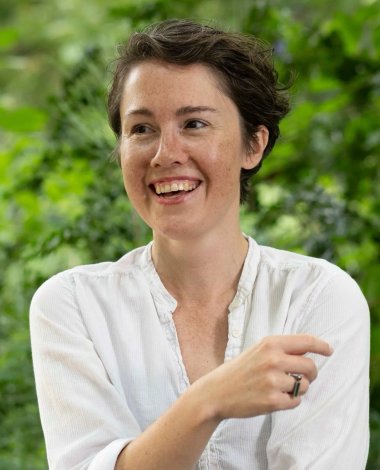
The Phil gave the premiere of The Observatory in 2019 at the Hollywood Bowl, and the work’s title refers to nearby Griffith Observatory, which overlooks L.A. and which Shaw hiked to one morning. Yet the music doesn’t really evoke galactic visions or even a sweeping view of the city. On a second listening, it remains more of a stream-of-consciousness tour of parts of European musical history, but now more imposing in sound and maybe a little ponderous in some stretches.
The big blasting chords that launch the piece certainly make a much more thunderous impact indoors than in the great dissipating outdoors. A repeated motive of seven notes is tossed among the sections. At one point, the instruments drop out so that the glockenspiel plays virtually alone. At Disney Hall, you could hear more of the quotations of famous works — J.S. Bach’s Brandenburg Concerto No. 3, the first movement of Jean Sibelius’s Symphony No. 2, the finale of Brahms’s Symphony No. 1, even Strauss’s Don Juan. Credit that to clearer acoustics and to Abrams’s astute balancing, which brought the allusions forth.
The risk-taking that this conductor thrives on came to the fore in George Gershwin’s Concerto in F, a favorite vehicle of pianist Jean-Yves Thibaudet, who, like the effortlessly eclectic Abrams, ventures into the jazz idiom now and then. Going for broke, the pair went at Gershwin very freely, bending the line with many extreme fluctuations in tempo and making dramatic symphonic work out of the introduction and elsewhere.
Oddly enough for these performers, there was very little jazz feeling most of the time, even when Thibaudet hammered away at the Charleston boogie in the first movement. But there was plenty of loud whipped-up frenzy at the ends of the outer movements, provoking predictably rousing applause. The pianist then tamed the flames with poetic restraint, playing a Brahms intermezzo as an encore.
The big-thinking, all-out, supersized orchestra approach was better suited to Also sprach Zarathustra — and Abrams had a solid grip on the piece, with a handful of slight liberties in tempo to give it some personality. He leaned into the turbulence, getting a rich lower-string sound and building tremendous excitement toward the climaxes, with the famous “Sunrise” episode making a potent, widescreen, pipe-organ-loaded impact.
Going back into Philharmonic history, Zubin Mehta made a spectacular LP of Zarathustra in 1968 that became a bestseller because Decca astutely recorded the piece just a month after 2001 came out. Abrams’s rendition was in that extroverted mold, albeit clearer in texture. If this was an audition, the conductor made an emphatic case for himself.
